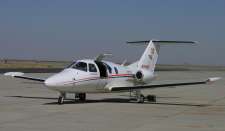Very light jet
Monday, 30 November -0001 00:00

A very light jet, entry-level jet or personal jet,previously known as a microjet, is a category of small jet aircraft approved for single-pilot operation, seating 4-8 people, with a maximum take-off weight of under 10,000 pounds (4,540 kg). They are lighter than what is commonly termed business jets and are designed to be flown by single pilot owners.
After a flurry of interest in the Small Aircraft Transportation System (SATS) and air taxi markets in the early 2000s, the VLJ sector underwent significant expansion. Several new designs were produced, such as the Embraer Phenom 100, the Cessna Citation Mustang, and the Eclipse 500. However, following the late 2000s recession the air taxi market underperformed expectations, and both Eclipse Aviation and air taxi firm DayJet collapsed. In December 2010, AvWeb's Paul Bertorelli explained that the term very light jet has lost favor in the aviation industry, "personal jet is the description du jour. You don't hear the term VLJ—very light jet--much anymore and some people in the industry tell me they think it's because that term was too tightly coupled to Eclipse, a failure that the remaining players want to, understandably, distance themselves from
Read more...UK summons Russian ambassador after military aircraft disrupt civil aviation
Monday, 30 November -0001 00:00

LONDON: Britain summoned the Russian ambassador on Thursday and asked him to explain why two Russian "Bear" long-range bombers had flown over the English channel the previous day, a move that forced British authorities to divert civil aircraft.
"The Russian planes caused disruption to civil aviation. That is why we summoned the Russian ambassador today to account for the incident," the foreign office said in a statement.
Typhoon fighter jets were scrambled to intercept the two Russian planes, which were flying close to UK airspace, on Wednesday.
The foreign office said the incident was part of an increasing pattern of "out of area operations" by Russian aircraft, noting the planes had stopped short of entering UK airspace.
A British government source told Reuters the Russian move was viewed as "a significant escalation" and was a change in strategy since Russian aircraft had previously largely confined themselves to flying close to Scotland.
"It was very dangerous. Civil aircraft flying to the UK had to be rerouted," the source said. "The Russians were flying with their transponders turned off so could only be seen on military radar. They haven't flown this far south before."
Read more...Our Packages



News & Events
Chennai International Airport completes its first phase of flood-proofing after deluge last year. Is it enough?
Monday, 14 November 2016 05:40
The employees of the Chennai International Airport can’t forget how water engulfed the tarmac on December…Nine flights diverted over Delhi smog
Monday, 07 November 2016 05:49
JAIPUR: Nine flights, including three chartered planes were delayed by 4-5 hours from landing in Delhi…From The Blog

